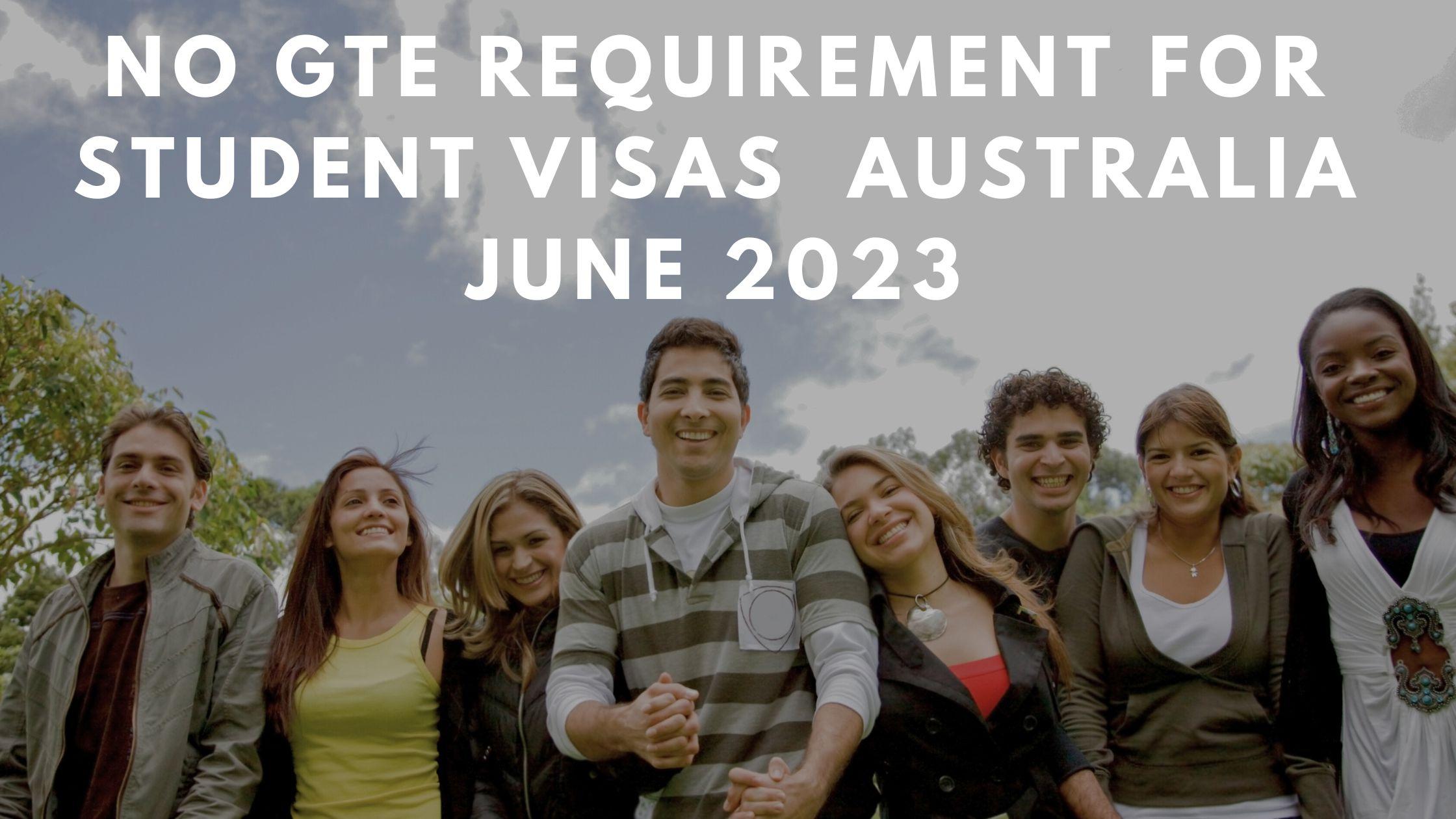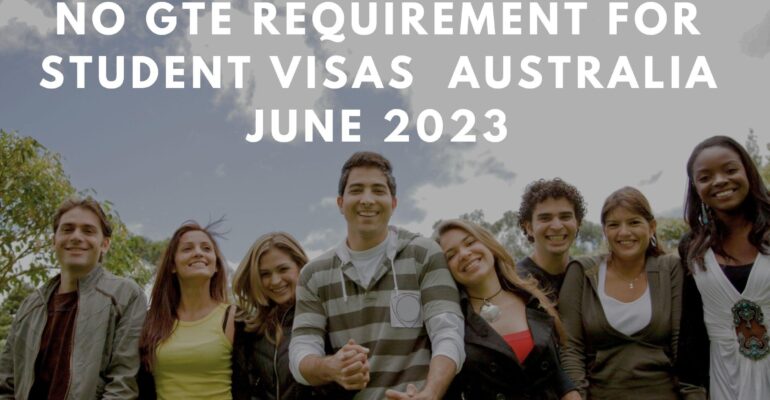No GTE Requirement for Student Visas in Australia – June 2023
July 7, 2023 2023-07-07 3:20No GTE Requirement for Student Visas in Australia – June 2023
No GTE Requirement for Student Visas in Australia – June 2023

Australia has long been a popular destination for international students seeking high-quality education and a vibrant multicultural experience. As part of the student visa application process, applicants were previously required to submit a personal statement addressing the Genuine Temporary Entrant (GTE) requirement. However, as of June 2023, the Australian Government's Department of Home Affairs has made a significant change – there is no longer a GTE requirement for student visas in Australia. This groundbreaking development provides more flexibility and ease for prospective international students. In this article, we will explore the implications of this policy change and provide valuable information for students considering studying in Australia.
The Elimination of the GTE Requirement
In November 2022, the Australian Government’s Department of Home Affairs made the decision to eliminate the GTE requirement for student visas. This change aims to simplify the application process and remove unnecessary barriers for international students. Previously, applicants were required to submit a personal statement explaining their genuine intention to study in Australia and not for any other purposes. Additionally, they had to assure that they would only reside in Australia for the duration allowed on their visa and not overstay. However, this requirement has now been abolished, relieving students of the burden of crafting a GTE statement.
Benefits of Removing the GTE Requirement
The elimination of the GTE requirement brings several benefits for international students considering studying in Australia. Let’s delve into some of these advantages:
1. Streamlined Visa Application Process
With the removal of the GTE requirement, the visa application process becomes more streamlined, efficient, and less time-consuming. Students no longer need to dedicate significant effort to writing a personal statement addressing their genuine intentions. This change allows applicants to focus more on other essential aspects of their application, such as gathering necessary documents and fulfilling academic requirements.
2. Reduced Stress and Anxiety
Crafting a GTE statement can be a daunting task for many students. It requires careful consideration of one’s motivations and intentions, which can lead to stress and anxiety. By eliminating this requirement, students can experience a more relaxed application process, enabling them to approach their studies in Australia with a positive mindset from the start.
3. Increased Accessibility for International Students
The removal of the GTE requirement also enhances accessibility for international students. It eliminates a potential barrier that may have deterred some students from pursuing their educational goals in Australia. This change opens doors for a broader range of students to experience the world-class education and multicultural environment that Australian institutions offer.
Supporting Documentation for Student Visa Applications
While the GTE requirement is no longer mandatory, it is still crucial for students to provide relevant documentation that supports their visa application. These supporting documents serve as evidence of the student’s genuine intentions to study in Australia. Let’s explore the types of documents that applicants should consider including:
1. Previous Study
Including academic transcripts and certificates from previous educational institutions is essential to demonstrate the student’s academic background and qualifications. It is advisable to provide details of the education providers, such as their names and contact information, to ensure the authenticity of the documents.
2. Study Gaps
If there are any gaps between the student’s previous studies or unfinished courses, it is important to provide an explanation for these gaps. This can help address any concerns regarding the student’s academic history and ensures transparency in the application process.
3. Employment History
Outline the details of any previous or current employment, including the company’s address, dates of employment, the student’s role, and contact information of the employer. This information demonstrates the student’s work experience and may contribute to their overall profile as a prospective student.
4. Employment Income
Providing proof of income from the last 12 months before lodging the visa application can strengthen the student’s case. This can be done through tax returns or bank statements, showcasing the student’s financial stability and ability to support themselves during their studies in Australia.
5. Potential Future Employment
If the student has received any job offers for employment after completing their course in Australia, it is important to note these offers in the application. Mentioning the expected salary and other benefits associated with these job offers can further demonstrate the student’s commitment to their chosen field of study and their potential contributions to the Australian workforce.
6. Financial, Family, or Social Ties
Outlining the reasons why the student intends to return home after their time in Australia is crucial to address any concerns about the student’s intentions. This can include financial ties, such as ownership of property or investments in their home country, family responsibilities, or social connections that provide a strong incentive for the student to return upon completing their studies.
The Future of International Students in Australia
The removal of the GTE requirement marks a significant milestone in Australia’s approach to welcoming international students. This change not only simplifies the visa application process but also highlights Australia’s commitment to attracting and retaining talented individuals from around the world. Furthermore, it opens up opportunities for students to explore post-study work rights and potential pathways to permanent residency, should they develop the skills and qualifications that Australia requires.
Conclusion
The elimination of the GTE requirement for student visas in Australia heralds a new era of accessibility and ease for international students. With a streamlined visa application process, reduced stress and anxiety, and increased opportunities for post-study work and permanent residency, Australia continues to solidify its position as a global education hub. As prospective international students consider their options, they can now embark on their educational journey to Australia with greater confidence and excitement.
Related Posts
Holo Education Services Earns 5-Star Rating on Google!
Good News for Aspiring Civil Construction Designers in Perth, Western Australia
Unlocking Your Future: The Importance of RPL Certification with Holo Education Services
Navigating the Pathways of Care: A Comprehensive Guide to Key Health and Care Qualifications
Unlocking Healthcare Excellence: HLT43021 Certificate IV in Allied Health Assistance
Search
Categories
- 10 Tips for International Students to Adapt to Studying in Australia (1)
- 2023 (1)
- A Comprehensive Guide to Certificate II in Community Pharmacy SIR20116 (1)
- A Guide for Fitness Professionals (1)
- AUR30620 – Certificate III In Light Vehicle Mechanical Technology (1)
- Australia: The Ultimate Study Destination for International Students (1)
- Balancing Work and Study as an International Student in Australia (1)
- BSB50320 Diploma of Human Resource Management (1)
- BSB50420 – Diploma of Leadership and Management (1)
- Celebrating Western Australia Day (1)
- Certificate IV in Disability (1)
- CHC30121 – Certificate III in Early Childhood Education and Care (1)
- CHC33015 – Certificate III in Individual Support (1)
- CHC43015 Certificate IV in Ageing Support (1)
- CHC43115 – Certificate IV in Disability (1)
- CHC43115- Certificate IV in Disability (1)
- CHC43315 Certificate IV in Mental Health (1)
- CHC50121 Diploma of Early Childhood Education and Care (1)
- CHC51015-Diploma-of-Counselling- (1)
- CHC52015 – Diploma of Community Services (1)
- Childcare Subsidies in Australia (1)
- Choosing the Right Australian University: Factors to Consider (1)
- CPC30220 Certificate III in Carpentry (1)
- CPC30620 – Certificate III in Painting and Decorating (1)
- CPC40120 Certificate IV in Building and Construction (1)
- FNS40222 Certificate IV in Accounting and Bookkeeping (1)
- Healthcare and Insurance in Australia for International Students (1)
- HOLO EDUCATION SERVICES (23)
- How to Collect Evidence for RPL (1)
- Navigating RPL Success: Avoiding Common Mistakes in Your RPL Application (1)
- SHB50121 – Diploma of Beauty Therapy (1)
- SIT30816 Certificate III in Commercial Cookery (1)
- SIT40516 certificate IV in commercial cookery (1)
- SIT50416 Diploma of Hospitality Management (1)
- SIT60322 Advanced Diploma of Hospitality Management (1)
- TAE40116 Certificate IV in Training and Assessment (1)
- The Australian Education System (1)
Latest Posts
Popular Tags











